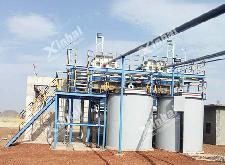

Warm Tip: If you want to know more details about equipment, solutions, etc, please click the button below for free consultation, or leave your requirements!
Ball mills are the main equipment used for grinding operations in many industries, such as mining, construction, ceramics, and glass industries.
According to the grinding way, the ball mill machine can be divided into wet ball mill and dry ball mill. The dry ball mill doesn’t need to add water, the product is usually powder grinding, the wet ball mill needs to add water, the material is ground to the fine size under the action of grinding medium and water.
So, what are the differences between wet ball mill and dry ball mill? And how should we choose them?
The working principle of wet ball mill and dry ball mill in grinding medium is basically the same. The rotation of the cylinder drives the grinding medium and material in the cylinder to move together, and finally grinding the material to the fine size through the impact of throwing, extrusion and other effects.
However, the discharging way of wet ball mill and dry ball mill is different. The outlet of dry ball mill is straight type, which adopts grate plate type to discharge uniformly; And the outlet of wet ball mill is trumpet type, which is built-in screw device, easy to discharge.
The difference between wet ball mill and dry ball mill is also shown in the auxiliary equipment. The dry ball mill will produce dust because there is no liquid added during the work. In order to avoid dust pollution, the auxiliary equipment, such as air device, dust pipe, dust collector, should be equipped. The wet ball mill doesn’t need to add auxiliary equipment.
On the grinding medium, the dry ball mill only needs to join the steel ball, while the wet ball mill needs to add liquid to participate in grinding except for steel ball. The commonly used proportion: steel ball: material: water = 4:2:1. But because the different materials nature, the actual ratio will be adjusted based on materials nature, which is generally determined by mineral processing test.

The difference between wet ball mill and dry ball mill is also shown in the scope of application. The dry ball mill requires that the material must be dry, cannot contain water, so it is suitable for the materials that will not produce other materials, such as cement, construction stone. The wet ball mill requires that the material cannot be changed by water, which is suitable for most kinds of ore.
The above compares the difference between the dry ball mill and the wet ball mill from four aspects, and here are the advantages of both kinds of ball mill machine.
Dry ball mill: uniform discharge, low failure rate, without full grinding, doesn’t need to add water, save the cost. But sometimes it will form a dead corner in the grinding process, the material in the dead corner is difficult to be ground.
Wet ball mill: Due to the participation of liquid, there is no material into a dead corner for the wet ball mill, and this ball mill machine is featured with high grinding efficiency, wide application range, continuous production, and without dust pollution. But the material after the wet grinding also need to be dried, increasing the cost.
Before choose the ball mill machine, it is suggested to consider the nature of the material firstly to see what kind of grinding way that is suitable to the material. If the material is cement, construction stone, etc., these materials encounter water will produce changes, which can only be treated with dry ball mill.
In addition, the requirements of the finished product should also be considered. The dry ball mill can be adopted if the fineness requirement of the finished product is not high, and the wet ball mill can be adopted if the fineness requirement of the finished product is high.
Besides, the dry ball mill should be adopted if the finished product needs to be stored in the form of powder or in the place of drought region.

The above briefly introduces the difference and selection conditions of wet ball mill and dry ball mill. In fact, how to choose the ball mill correctly depends on the requirements of the subsequent operation of the ball mill or the actual conditions at that time.
Last: What Are Common Types of Crushers Used in the Mineral Processing?
121 Factors You Must Know About Ball Mill Liner
 5
5
 9432
9432
2Causes and Solutions of Ball Mill Noise
 0
0
 3477
3477
3Ball Mill VS AG Mill: What are the Similarities and Differences?
 1
1
 6608
6608


What Are the Differences Between CIP and CIL?
 11264
11264
 0
0